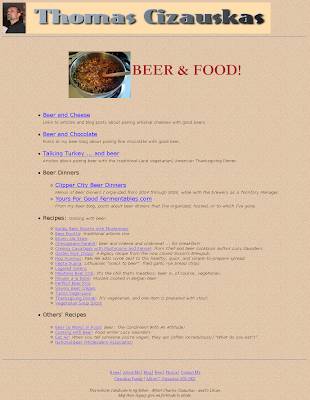 I'm a vegetarian who appreciates that fine vegetarian foodstuff —beer. Thus it was quite accommodating of the Royal Mile Pub's Chef Ian Morrison to offer vegetarian choices at his recent beer breakfast.
I'm a vegetarian who appreciates that fine vegetarian foodstuff —beer. Thus it was quite accommodating of the Royal Mile Pub's Chef Ian Morrison to offer vegetarian choices at his recent beer breakfast.
At my blog post recapping the breakfast, a reader had this request:
As a beer loving vegetarian I'd appreciate it if you could go more in detail on the veggie options offered and how they paired with the beers
So...
APPETIZERSOrange Cranberry Scones, Potato Pancakes with Creme Fraiche, Beignets, Cheese Rolls
This was vegetarian, but not vegan (cheese, eggs). We vegetarians were also offered asparagus wrapped in a yellow bell pepper sheet.
The beer pairing— Clipper City Hang Ten Weizen Dopplebock— with its strong banana, allspice, and chocolate flavors, was almost like an additional appetizer. We reserved half of this 10% alcohol by volume beer (abv). More on that later.
1st COURSECherry Whole Grain Pancakes with Quelque Chose Syrup
Vegetarian, but not vegan: eggs and milk in the pancake.
When I prepare pancakes at home, I substitute soy milk, hefeweizen, and banana for the milk and eggs in the batter. Chef Morrison's syrup —made with a reduction of a tart strong cherry beer from Unibroue just outside of Montreal— was delicious!
The pairing was less successful: a Berliner-weisse style beer from in Leipzig Germany. Appropriate for the style, it contained only only 3% abv. But I found it a light, less sour interpretation of the classic style. It was served with a side of raspberry syrup (with which to spike the beer, as done in Germany). This may have been a better beer with which to begin the breakfast.
2nd COURSEHousemade Smoked German Style Sausage with Cumberland Sauce
Paired with
Paulaner SalvatorVegan: Boca brand sausage, sauerkraut, port-wine citrus
Cumberland sauce. Good hearty, classic pairing.
MAIN COURSEPork Schnitzel or Gravlax scrambled eggs
Vegan option: baked beans over toast with roasted tomato slices, veggie-fried frites.
I paired with a smoked beer,
Aecht Schlenkerla Rauch Marzen. Other options were Clipper city's Small Craft Warning Über Pils —that many paired with their Gravlax eggs— and
Tröegenator Double Bock.
 DESSERT
DESSERTIndividual Chocolate Cake
Vegetarian, but not vegan: dairy and egg.
Schneider
Aventinus Weizen Doppelbock (8% abv) was simply delicious with the cake. The kitchen had prepared these 40+ individual chocolate cakes, no easy feat for a a simultaneous presentation.
Several us compared the Aventinus with the Hang Ten. The brown hues were similar, as were the fruity aromas and flavors. Hang Ten had a slightly hotter character from its higher alcohol level.
By the way, Great Sage, a local vegetarian restaurant, produced a beer
dinner in July at which
all the food was vegetarian. Read more
here.
 Chad Dukes, co-host of the Big O and Dukes radio program on WJFK-FM in northern Virginia, holds a bottle of Clipper City Brewing's Small Craft Warning Uber Pils.
Chad Dukes, co-host of the Big O and Dukes radio program on WJFK-FM in northern Virginia, holds a bottle of Clipper City Brewing's Small Craft Warning Uber Pils.





.png)





